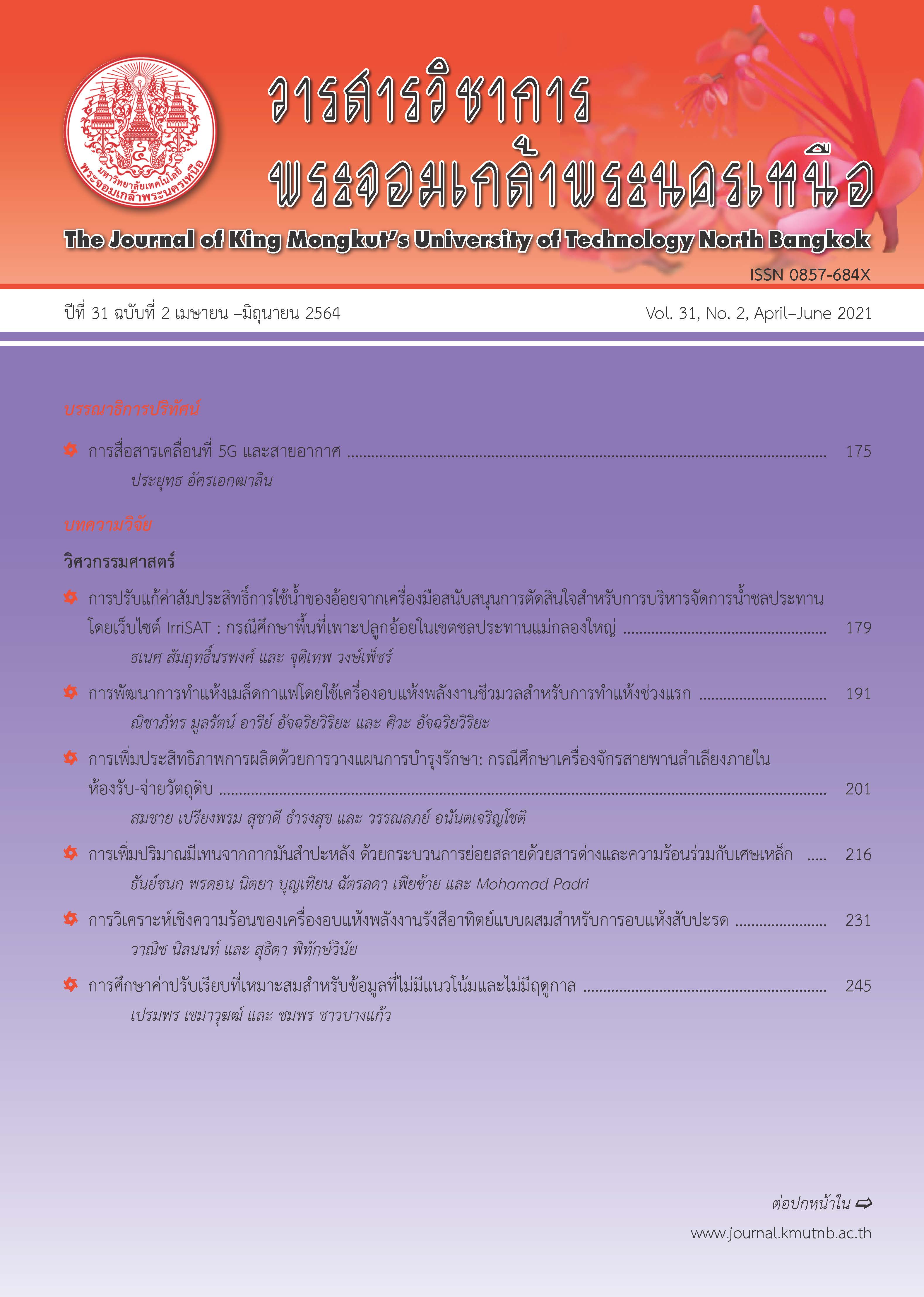การศึกษาค่าปรับเรียบที่เหมาะสมสำหรับข้อมูลที่ไม่มีแนวโน้มและไม่มีฤดูกาล
Main Article Content
บทคัดย่อ
งานวิจัยนี้มีวัตถุประสงค์เพื่อหาค่าปรับเรียบ (α) ที่เหมาะสมที่สุดของวิธีการปรับเรียบเอกซ์โพเนนเชียลแบบง่าย (SES) โดยทดสอบกับข้อมูลอนุกรมเวลาแบบไม่มีแนวโน้มและไม่มีอิทธิพลของฤดูกาลจำนวน 5,000 ชุด โดยมีสัมประสิทธิ์ของความแปรปรวนไม่เกิน 30% ในการกำหนดค่าปรับเรียบไม่ได้มีการกำหนดค่าปรับเรียบที่ชัดเจนว่าควรมีค่าเท่าใดจึงจะพยากรณ์ข้อมูลได้ถูกต้องหรือมีความแม่นยำของการพยากรณ์มากที่สุด งานวิจัยนี้พบว่าผลการเปรียบเทียบ (0< α <1) โดยค่าเพิ่มขึ้นทีละ 0.1 ปรากฎว่าค่าปรับเรียบเท่ากับ 0.1 ให้ค่าคลาดเคลื่อนของการพยากรณ์ด้วยวิธีค่าเฉลี่ยเปอร์เซ็นต์ความคลาดเคลื่อนสัมบูรณ์น้อยที่สุดกับข้อมูลที่มีความแปรปรวนน้อย นอกจากนี้ ผู้วิจัยยังได้ทดสอบความสามารถของการพยากรณ์โดยนำวิธี SES ที่กำหนดค่าปรับเรียบเท่ากับ 0.1 ไปเปรียบเทียบกับวิธีพยากรณ์อื่นๆ อีก 4 วิธี ที่เหมาะสมกับข้อมูลที่ไม่มีแนวโน้มและไม่มีฤดูกาล ผลปรากฎว่าวิธี SES ให้ค่าคลาดเคลื่อนของการพยากรณ์ต่ำที่สุด
Article Details
บทความที่ลงตีพิมพ์เป็นข้อคิดเห็นของผู้เขียนเท่านั้น
ผู้เขียนจะต้องเป็นผู้รับผิดชอบต่อผลทางกฎหมายใดๆ ที่อาจเกิดขึ้นจากบทความนั้น
เอกสารอ้างอิง
[2] P.Tapparak and P.Payakkapong, “Forecasting of agricultural product price in the futures market: A case study of rubber,”in Proceedings of Kasetsart University, 2004, pp. 125–131 (in thai).
[3] Y. Atikankul, “Forecasting agricultural products by exponential smoothing,” M.S. thesis, Faculty of Science and Technology Rajamangala University of Technology Phra Nakorn, 2013 (in Thai).
[4] P. Khatunya, “A study of forecasting methods with time series technique and regression analysis,” M.S. thesis, Department of Statistics, Faculty of Science Kasetsart University, 2005 (in Thai).
[5] C. Theeraviriya, “A comparison of the forecasting method for electric energy demand in Nakhon Phanom province,”Journal of Naresuan University, vol. 25, no. 4, pp. 124–137, 2017 (in Thai).
[6] W. Poonsuan, “A forecasting system for the household manufacturer a case study S.B. Funiture Co.,Ltd.,” Independent Study, Department of Industrial Management Engineering, Faculty of Engineering King Mongkut’s Institute of Technology North Bangkok, 2007 (in Thai).
[7] T. Kullpattaranirun, “Using forecasting techniques for inventory management,” MUT Journal of Business Administration Review, vol. 2, no. 2, pp. 6–14, 2012 (in Thai).
[8] K. Aggalugpho, “A Decision support system of forecasting for Kraft paper demand a company case study in Kraft paper industry,” M.S. thesis, Department of Industrial Engineering, Faculty of Engineering King Mongkut’s University of Technology North Bangkok, 2008 (in Thai).
[9] K. Kaewthong, “A study of time series forecasting for production a case study of heat insulation manufacturer,” TNI Journal of Business Administration and Languages, vol. 1, no. 1, pp. 1–4, October 2012 – March 2013 (in Thai).
[10] N. Udomsri, “The design of a forecasting support models on demand of durian for domestic and export markets by time series and artificial neural networks (ANNs),” M.S. thesis, Department of Industrial Engineering, Faculty of Engineering King Mongkut’s University of Technology North Bangkok, 2011 (in Thai).
[11] N. Niruttikul, Sales Forecasting. Bangkok: Kasetsart University Press, 2015 (in Thai).
[12] K. Visitsakulchai and K. Nimanan, “Inventory management of visit construction (1994) limited partnership,” CMU Journal of Business, vol. 2, no. 3, pp. 62–80, 2016 (in Thai).
[13] N. Luangtong and N. Kantanantha, “Selection of the appropriate agricultural yield forecasting models,” Journal of Science and Technology, vol. 24, no. 3, pp. 370 – 381, 2016 (in Thai).
[14] P. Srichuen, “Forecasting for incidental demand entries,” M.S. thesis, Department of Industrial Engineering, Faculty of Engineering Kasetsart University, 2000 (in Thai).
[15] S. Everette and Jr. Gardner, “Exponential smoothing: The state of the art —Part II,” Journal of Forecasting, vol. 4, no.1, pp. 1– 28, 1985.
[16] B. L. Bowerman and R.T. O’Connell, Forecasting and Time Series: An Applied Approach, 3rd ed, California: Duxbury Press, 1993.
[17] B. Billah, M. L. King, R. D. Snyder, and A. B. Koehler, “Exponential smoothing model selection for forecasting,” International Journal of Forecasting, vol. 22, no. 2, pp. 239– 247, 2006.
[18] W. Keerativibool, “Forecasting the export quantity of rubber compound,” Srinakharinwirot Science Journal, vol. 30, no. 2, pp. 41–56, 2014 (in Thai).
[19] P. Tengsuwan and K. Punphong, “Vitamin E: Market conditions and import forecasts of Thailand,” Journal of Economics and Management Strategy, vol. 1, no. 1, pp. 96–106, 2014 (in Thai).
[20] L. Thavornsin, “Sales forecasting in the lubricant industry with factors of demand and economic indicators: A case study of Lube- Technology co., Ltd.,” Independent Study, Department of Finance, Faculty of Business Administration, University of the Thai Chamber of Commerce, 2013 (in Thai).
[21] P. Wongsunopparat and R. Chaveesuk, “Sales forecasting of traditional medicine using time series forecasting techniques,”in Proceedings of 50th Kasetsart University Annual Conference: Agro-Industry, 2012, pp. 244–251 (in Thai).
[22] C. Zhichu, “Allowable limit of error in clinical chemistry quality control,” Journal of Clinical Chemistry, vol. 35, no. 4, pp. 630–631, 1989.
[23] P. Labkead and T. Wasusee, “Planning resource needs to optimize the export process,” in Proceeding of Thai VCML conference 9th, 2009, pp. 244–256, (in Thai).
[24] C.D. Lewis, Industrial and Business Forecasting Methods. London: Butterworths, 1982.

